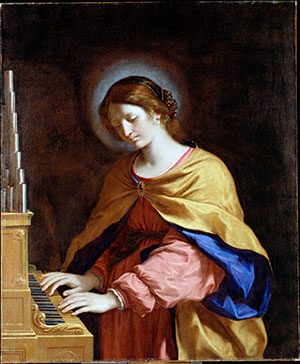 Because St. Cecilia is the patron saint of music, countless young girls, the author included, have chosen her for their patron saint. Other saints are connected to music, of course, such as St. Gregory the Great, for whom Gregorian chant is named, and St. Hildegard von Bingen, a phenomenal medieval composer. But St. Cecilia maintains a special place in the heart of Catholic musicians. November is a fitting month to feature St. Cecilia, whose feast day is Nov. 22.
Because St. Cecilia is the patron saint of music, countless young girls, the author included, have chosen her for their patron saint. Other saints are connected to music, of course, such as St. Gregory the Great, for whom Gregorian chant is named, and St. Hildegard von Bingen, a phenomenal medieval composer. But St. Cecilia maintains a special place in the heart of Catholic musicians. November is a fitting month to feature St. Cecilia, whose feast day is Nov. 22.
Music has been written in her honor by both Catholic and non-Catholic renowned composers, such as Henry Purcell, F.J. Haydn and Benjamin Britten. G.F. Handel’s “Ode for St. Cecilia’s Day,” an extended work for chorus, soloists, orchestra and organ, is of particular interest.
The Baroque composer was born in Halle, Germany, where he studied organ with Friedrich Zachow. Handel was considerably more mobile than his contemporaries, absorbing musical influences from his native Germany as well as Italy, where he lived for a short time, and finally England, where he made his eventual home. When the English public lost interest in Italian opera, he turned to oratorios, the genre for which he is most remembered today. “Ode for St. Cecilia’s Day” dates to the late 1730s between two of his most important oratorios: “Israel in Egypt” and “Messiah.”
The text for Handel’s work derives from the 1687 “Song for St. Cecilia’s Day” by John Dryden, where each stanza is dedicated to a specific instrument – in order of appearance: the trumpet, flute, violin and organ.
The organ is the instrument that remained significant throughout the composer’s life, and it is the instrument with which St. Cecilia is most associated. Thus, the stanza mentioning the organ places it in the foreground rather than its usual place in the oratorio, filling in background harmonies beneath the orchestra and chorus.
The stanza about the organ, as printed in the 1865 Deutsche Händelgesellschaft edition, reads: “But oh! What art can teach, What human voice can reach The sacred Organ’s praise? Notes inspiring holy love, Notes that wing their heav’nly ways to join the choirs above.”
The movement begins with the organ playing sustained chords while the rest of the small orchestra (strings, bassoon and harpsichord) accompanies. Once the soprano enters with the text, the voice is given the place of primacy, which allows the listener to clearly understand the text. However, after each vocal statement of “sacred organ’s praise,” there is a small response echoed by the organ. A quiet, but profound, organ solo closes the work.
As the “Ode” progresses, a soprano sings a very brief number explaining how when St. Cecilia’s organ played, an angel heard the beautiful sound and confused earth with heaven. This is then followed by a grand chorus as only Handel could write.
The premiere of this work occurred on the Feast Day of St. Cecilia, Nov. 22, 1739. The immense popularity of Handel’s other choral works has certainly eclipsed the “Ode for St. Cecilia’s Day,” but it is still a profound work worthy of attention, particularly as we celebrate her feast day.
— Christina L. Reitz, Ph.D., Special to the Catholic News Herald. Christina L. Reitz, Ph.D., is a professor of music at Western Carolina University in Cullowhee.
Watch online
The Dunedin Consort, a Baroque ensemble based in Edinburgh, Scotland, performs the aria “But O! What Art Can Teach” from Handel’s “Ode for St. Cecilia’s Day.”


